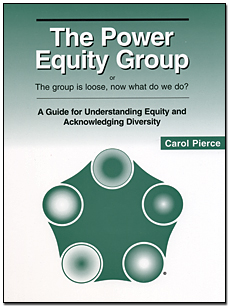newdynamics Publications is a voice for women and men of diverse races, cultures, and callings who experience life as a creative journey.
The Power Equity Group Model is a new and revolutionary way to understand groups.
Can you imagine a group model where conflict about leadership and authority are not the central focus?

193 pp. 6th edition, ©2018
ISBN 0-929767-05-5
(Dimensions:9" x 11")
Publishers: newdynamics Publications
List US $28.00
Bulk Prices available
ISBN 0-929767-05-5
(Dimensions:9" x 11")
Publishers: newdynamics Publications
List US $28.00
Bulk Prices available
A Power Equity Group:
- Requires us to act on a world view of cooperation, rather than competition;
- Heightens awareness of diversity and enables members to value and work with it;
- Empowers both individuals and the group;
- Facilitates leadership emerging in ways that enhance the work of the group;
- Is a dramatic tool for personal and group change processes; and
- Taps the personal sense of the spirit, as well as the larger sense of the universe.
Table of Contents
Author
Carol Pierce, a member of the NTL Institute, is a process consultant and diversity trainer. She was a founding partner of newdynamics in 1972. As an innovator in the field of organization development diversity education, she is a developer of widely-use models for gender, race and cultural, and sexual orientation work.
Ms. Pierce is a creator of the Power Equity Group theory and model which demonstrates how flatter, more egalitarian structures enhance creativity and acknowledge the full range of diversity among members of a group. She is a founder of the Power Equity Training Group, which makes this innovative method available to those who facilitate and work in groups.
Reader Comments about A Power Equity Group:
“I find Power Equity Group Theory to be enormously helpful in both my work with individuals and groups. It is truly cutting edge theory.”
Anne Litwin, Executive Coach, Organization Development Consultant, Past-Chair of the NTL Institute Board of Directors
“We have forgotten about attentiveness - how to pay attention to something greater than ourselves.” Lynda Stolzman, President, Lynda Stolzman Associates, Inc., Organization Development Consultant, St. Petersburg, Florida
“Power Equity Group work helps us understand why many diversity interventions turn out to be less effective than we hoped. The Power Equity Group model provides diversity practitioners with a critical knowledge base and skills necessary far the field of diversity work.” Ben Harrison, Ph.D., Diversity /Organization Development Consultant, Member of NTL Institute, former Internal Diversity Consultant for Hewlett-Packard Company
“I find the Power Equity Group (PEG) lab, upon which this book is based, to be a profound experience. Personal and professional learning are blended. I encourage teachers, consultants, coaches, and anyone who works with people to experience a PEG lab in order to more clearly understand the value of PEG theory. They will be better prepared to support clients as they respond to contemporary diversity issues.” Jacqueline Bearce, Ed.D., Past Board Member of NTL Institute, Psychologist, Organization Development Consultant, Executive Coach, Diversity Trainer
“I value how The Power Equity Group brings the different voices of diversity, such as gender, race, and culture, into the room. The dynamics of difference can be acknowledged and processed in a way that supports self-awareness and learning.” Joel Shapiro, MSW, Director of Employee Assistance & Wellness Programs, University of Vermont, psychotherapist.
Top of Page ↑